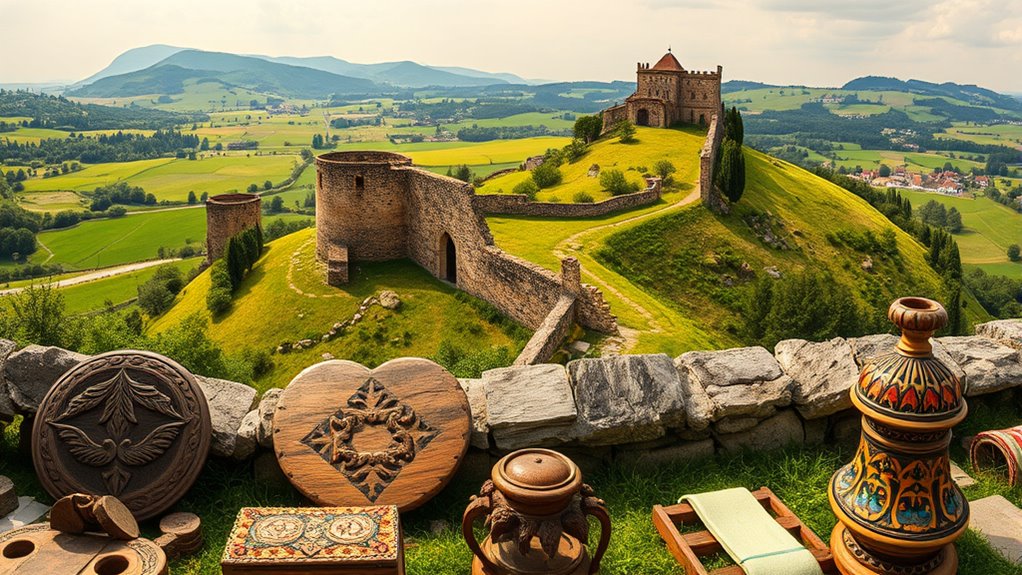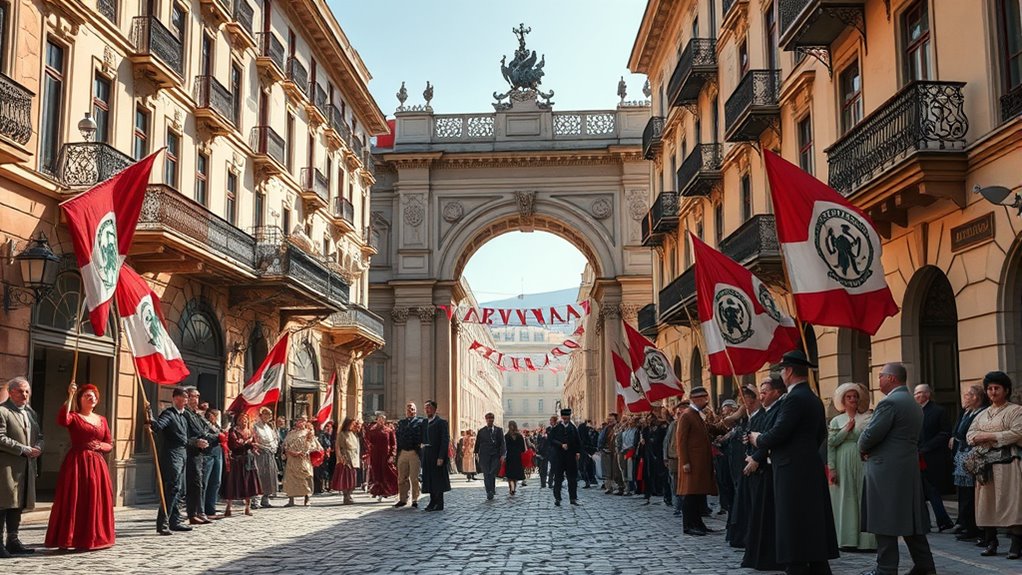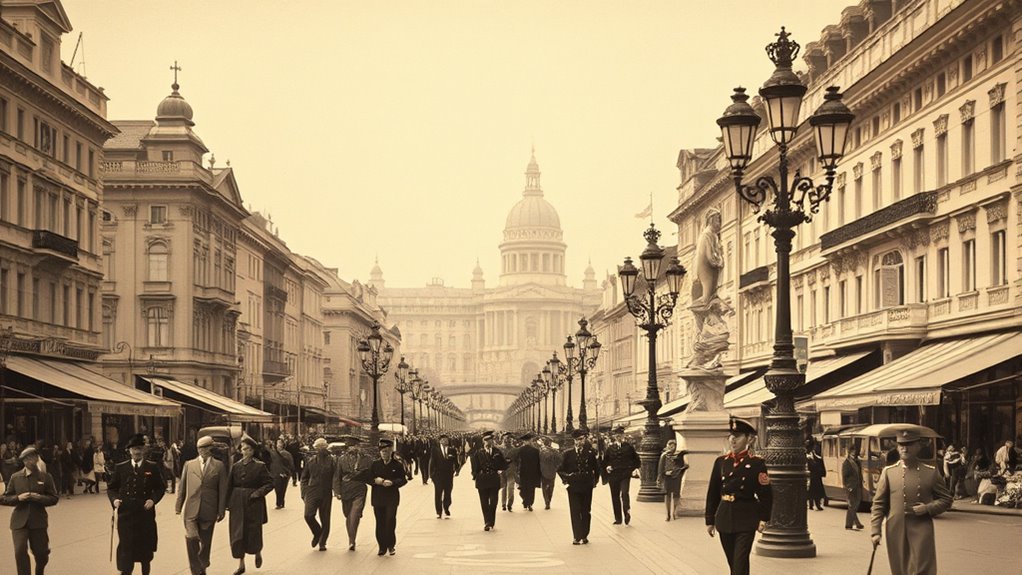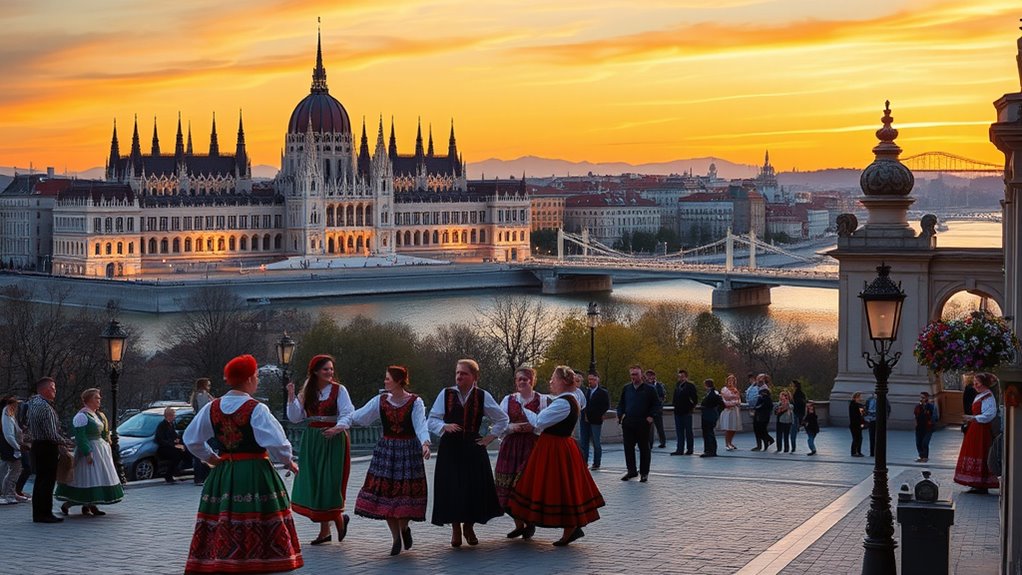Hungary’s history begins with Magyar tribes settling in the Carpathian Basin around 895 AD, shaping a nation with a strong medieval kingdom, resilience against Ottoman conquest, and an influential dual monarchy era. Its culture blends folk traditions, art, and cuisine like goulash, reflecting centuries of transformation. From ancient roots to modern democracy and EU membership, Hungary’s story is rich and layered, offering fascinating insights that unfold as you explore its unique historical journey and vibrant cultural identity.
Key Takeaways
- Hungary’s history begins with Magyar tribes settling in the Carpathian Basin around 895 AD, establishing a Christian kingdom in 1000 AD.
- The Ottoman occupation (1526-1686) divided Hungary into Habsburg-controlled, Ottoman, and autonomous Transylvania regions.
- The 19th century saw national revolutions, modernization, and the 1867 Austro-Hungarian dual monarchy fostering cultural and political growth.
- Post-World War I, Hungary faced territorial losses via the Treaty of Trianon, leading to political upheaval and national trauma.
- Contemporary Hungary embraces its rich cultural heritage through arts, folk traditions, cuisine, and modern societal developments within the EU.
Origins and Early Kingdom

Have you ever wondered where Hungary’s roots lie? It all began around 895-896 AD when Magyar tribes, led by Árpád, settled in the Carpathian Basin. These tribes forged the foundation of what would become Hungary. In 1000 AD, King Stephen I was crowned, establishing the first Christian kingdom and strengthening national unity. His efforts laid the groundwork for a centralized state and Christian culture. Despite setbacks like the devastating Mongol invasion of 1241, Hungary persisted, eventually thriving under leaders like János Hunyadi and Matthias Corvinus in the 15th century. Their military campaigns and cultural achievements marked a renaissance period. Before the Ottoman conquest, Hungary was a resilient kingdom, rooted in a blend of tribal traditions and Christian authority, shaping Hungary’s early identity. The early medieval period played a crucial role in shaping Hungary’s cultural and political landscape.
Ottoman Conquest and Partition

After Hungary had established itself as a resilient Christian kingdom, its borders and sovereignty faced a new threat in the early 16th century. The Battle of Mohács in 1526 marked a decisive Turkish victory, initiating 150 years of Ottoman occupation. You’d see Hungary split into three parts: the Habsburg-controlled west and north, the Ottoman central region, and the Transylvanian principality in the southeast. Transylvania became a hub of Hungarian culture and autonomy under Ottoman influence, while Buda was recaptured in 1686, shifting power toward the Habsburgs. This table summarizes key aspects of this period:
| Region | Control | Significance | Key Event |
|---|---|---|---|
| Western Hungary | Habsburgs | Political stability, Habsburg rule | 1686 recapture |
| Central Hungary | Ottoman Empire | Military presence, occupation | 1526 Battle of Mohács |
| Transylvania | Autonomous principality | Cultural hub, semi-independence | 1541 recognition |
| Northern Hungary | Habsburgs | Defense, administration | Post-1686 |
19th Century Reforms and Revolution

In the 19th century, Hungary set out on a period of reform aimed at modernization and strengthening national identity. You experience a surge of nationalist ideas, pushing for civil rights, political autonomy, and social change. The 1848 revolution marks a pivotal moment when you demand independence, abolition of serfdom, and democratic freedoms. Although Austria’s emperor initially accepts some demands, opposition from Franz Joseph I leads to military suppression and the revolution’s collapse. Leaders like Lajos Kossuth and Lajos Batthyány rally support, but ethnic minority rebellions back the Habsburgs. Despite the defeat, these efforts ignite a lasting sense of national consciousness. The period sets the stage for Hungary’s future struggles for sovereignty and cultural independence within a changing Europe. Additionally, the influence of historical reforms during this time laid the groundwork for Hungary’s ongoing pursuit of self-determination and cultural preservation.
Austro-Hungarian Dual Monarchy and World War I

The creation of the Austro-Hungarian Dual Monarchy in 1867 marked a turning point for Hungary, granting it greater autonomy within the empire while maintaining a shared monarch and foreign policy. This arrangement allowed Hungary to develop its own political institutions, economy, and military, fostering national pride. The late 19th century saw rapid industrialization, urbanization, and social change, fueling nationalist sentiments. As Europe edged toward conflict, Hungary aligned with Austria in supporting the Austro-Hungarian Empire’s interests. When World War I erupted in 1914, Hungary committed significant resources and troops to the war effort. The war’s end in 1918 brought defeat, disintegration of the empire, and territorial losses for Hungary through the Treaty of Trianon, leaving millions of Hungarians outside its borders and sparking social and political upheaval. Additionally, the period was marked by technological advancements that influenced both the military strategies and economic development of Hungary during this era.
Post-Communist Era and Contemporary Culture

Hungary’s shift from a communist regime to a democratic republic in 1989 marked a new chapter in its history. You experience a nation reconnecting with its traditions while embracing modern European values. The transition sparked political reforms, economic liberalization, and increased international integration, including joining the European Union in 2004. You can see this blend in Hungary’s vibrant arts scene, lively folk festivals, and contemporary music, which preserve Magyar roots while reflecting global influences. Hungarian cuisine remains an essential part of national identity, with dishes like goulash and paprika-based specialties. Today, Hungary navigates balancing its rich cultural heritage with the pressures of globalization, fostering a society that values its unique history while actively participating in the broader European community. Additionally, the country’s efforts to address historical trauma are reflected in its national commemorations and cultural dialogues.
Frequently Asked Questions
How Did Hungarian Cuisine Evolve Through History?
Hungarian cuisine evolved through centuries of cultural influences, blending Magyar traditions with Ottoman, Central European, and Balkan flavors. You’ll find that paprika, introduced during Ottoman rule, became essential, shaping dishes like goulash. As Hungary modernized, ingredients and cooking techniques diversified, reflecting trade and industrialization. Today, you enjoy a rich culinary heritage that balances hearty, spicy flavors with refined techniques, showcasing Hungary’s unique history and cultural blending.
What Are Hungary’s Most Famous Traditional Festivals?
Imagine stepping into a lively tapestry, woven with vibrant colors and rhythmic beats—that’s Hungary’s most famous festivals. You’ll experience the Budapest Spring Festival, celebrating arts and music, and the Busójárás, a lively masquerade marking winter’s end. At Szent István’s Day, fireworks light up the sky. These festivals invite you to dance, sing, and immerse yourself in Hungary’s rich traditions, making every moment a joyful celebration of its cultural spirit.
How Has Hungarian Language Preserved Ancient Roots?
Hungarian language has preserved its ancient roots through its unique Uralic origin, making it distinct from neighboring Indo-European languages. You’ll notice this in its complex grammar, extensive vowel harmony, and rich vocabulary that traces back thousands of years. Despite influences from Latin, Turkish, and Slavic languages, Hungarian maintains core structures and words that connect you directly to your ancestors’ linguistic heritage, keeping the language vibrant and historically rooted.
What Are Hungary’s Iconic Folk Arts and Crafts?
You’ll love Hungary’s iconic folk arts and crafts, like vibrant embroidery, colorful pottery, and intricate wood carvings. These crafts reflect deep traditions and regional styles, often featuring floral and geometric patterns. You can see them in embroidered textiles, decorative ceramics, and handcrafted furniture. These arts aren’t just beautiful—they’re a living expression of Hungarian identity, passed down through generations, making each piece a unique piece of cultural history.
How Does Hungary Celebrate Its National Holidays Today?
You can celebrate Hungary’s national holidays by participating in vibrant festivals, parades, and traditional ceremonies. On March 15th, you’ll join commemorations of the 1848 Revolution with patriotic events and street performances. August 20th marks St. Stephen’s Day with fireworks, church services, and national flags waving across towns. During these days, locals gather to honor their history, enjoy folk music, dance, and traditional food, fostering a strong sense of national pride.
Conclusion
As you explore Hungary’s rich history, remember that every cloud has a silver lining. From its early origins to modern times, Hungary’s resilience shines through, shaping a vibrant culture you can enjoy today. Embrace its legacy, and you’ll discover that history isn’t just about the past—it’s a guiding light for the future. Like they say, every ending is a new beginning, so keep exploring and appreciating Hungary’s enduring spirit.









